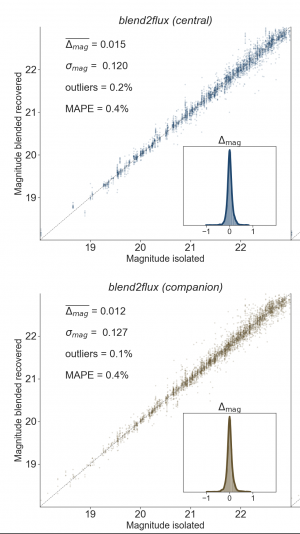Photometry of high-redshift blended galaxies using deep learning
The new generation of deep photometric surveys requires unprecedentedly precise shape and photometry measurements of billions of galaxies to achieve their main science goals. At such depths, one major limiting factor is the blending of galaxies due to line-of-sight projection, with an expected fraction of blended galaxies of up to 50%.
Current deblending approaches are in most cases either too slow or not accurate enough to reach the level of requirements. This work explores the use of deep neural networks to estimate the photometry of blended pairs of galaxies in monochrome space images, similar to the ones that will be delivered by the Euclid space telescope. Using a clean sample of isolated galaxies from the CANDELS survey, we artificially blend them and train two different network models to recover the photometry of the two galaxies. We show that our approach can recover the original photometry of the galaxies before being blended with ~7% accuracy without any human intervention and without any assumption on the galaxy shape.
This represents an improvement of at least a factor of 4 compared to the classical SExtractor approach. We also show that forcing the network to simultaneously estimate a binary segmentation map results in a slightly improved photometry.
Full citation: Boucaud et al., 2020, MNRAS, Volume 491, Issue 2, p.2481-2495
This project is a result from COIN Residence Program #5 – Chania, Greece/2018.
- Alexandre Boucaud, APC/U. Paris-Diderot (France)
- Marc Huertas-Company, Instituto de Astrofisica de Canarias (Spain)
- Caroline Heneka, Scuola Normale Superiore di Pisa (Italy)
- Emille E. O. Ishida, CNRS/UCA (France)
- Nima Sedaghat, U. Freiburg (Germany)
- Rafael S. de Souza, U. North Carolina (USA)
- Ben Moews, U. Edinburgh (UK)
- Herve Dole, U. Paris-Saclay (France)
- Marco Castellano, INAF (Italy)
- Emiliano Merlin, INAF (Italy)
- Valerio Roscani, INAF(Italy)
- Andrea Tramacere, U. Geneva (Switzerland)
- Madhura Killedar, U. Sydney (Australia)
- Arlindo M. M. Trindade, Industry (UK) and U. do Porto (Portugal)






